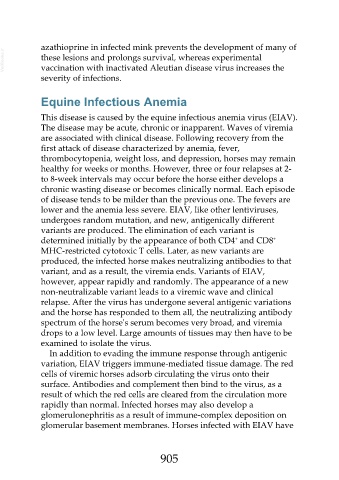Page 905 - Veterinary Immunology, 10th Edition
P. 905
azathioprine in infected mink prevents the development of many of
VetBooks.ir these lesions and prolongs survival, whereas experimental
vaccination with inactivated Aleutian disease virus increases the
severity of infections.
Equine Infectious Anemia
This disease is caused by the equine infectious anemia virus (EIAV).
The disease may be acute, chronic or inapparent. Waves of viremia
are associated with clinical disease. Following recovery from the
first attack of disease characterized by anemia, fever,
thrombocytopenia, weight loss, and depression, horses may remain
healthy for weeks or months. However, three or four relapses at 2-
to 8-week intervals may occur before the horse either develops a
chronic wasting disease or becomes clinically normal. Each episode
of disease tends to be milder than the previous one. The fevers are
lower and the anemia less severe. EIAV, like other lentiviruses,
undergoes random mutation, and new, antigenically different
variants are produced. The elimination of each variant is
+
determined initially by the appearance of both CD4 and CD8 +
MHC-restricted cytotoxic T cells. Later, as new variants are
produced, the infected horse makes neutralizing antibodies to that
variant, and as a result, the viremia ends. Variants of EIAV,
however, appear rapidly and randomly. The appearance of a new
non-neutralizable variant leads to a viremic wave and clinical
relapse. After the virus has undergone several antigenic variations
and the horse has responded to them all, the neutralizing antibody
spectrum of the horse's serum becomes very broad, and viremia
drops to a low level. Large amounts of tissues may then have to be
examined to isolate the virus.
In addition to evading the immune response through antigenic
variation, EIAV triggers immune-mediated tissue damage. The red
cells of viremic horses adsorb circulating the virus onto their
surface. Antibodies and complement then bind to the virus, as a
result of which the red cells are cleared from the circulation more
rapidly than normal. Infected horses may also develop a
glomerulonephritis as a result of immune-complex deposition on
glomerular basement membranes. Horses infected with EIAV have
905

